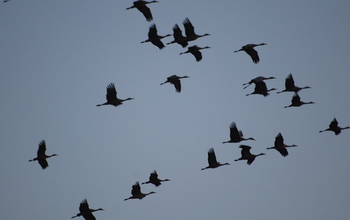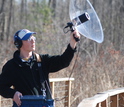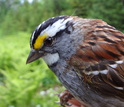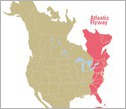Hola amigos: A VUELO DE UN QUINDE EL BLOG., Utilizando técnicas desarrolladas recientemente para el análisis de los datos de radar meteorológico Doppler, los investigadores analizaron los impedimentos - vientos cruzados y océanos - frente a la migración de las aves nocturnas, en el este de América del Norte.
Los migrantes la deriva hacia los lados en los vientos cruzados, los científicos descubrieron, pero compensados por que la deriva cerca de la costa atlántica.
Capacidad de las aves migratorias costeras 'para compensar la deriva del viento aumentó durante la noche, pero no se observaron cambios fuertes en zonas de interior. El comportamiento sugiere que las aves se adaptan en vuelo y compensar la deriva del viento cerca de las zonas costeras.
Los migrantes la deriva hacia los lados en los vientos cruzados, los científicos descubrieron, pero compensados por que la deriva cerca de la costa atlántica.
Capacidad de las aves migratorias costeras 'para compensar la deriva del viento aumentó durante la noche, pero no se observaron cambios fuertes en zonas de interior. El comportamiento sugiere que las aves se adaptan en vuelo y compensar la deriva del viento cerca de las zonas costeras.
More information...........
Weather radar offers new view of nocturnal bird flight
 Credit and Larger Version |
Using recently developed techniques for analyzing Doppler weather radar data, researchers looked at the impediments -- crosswinds and oceans -- facing nighttime-migrating birds in eastern North America.
The migrants drifted sideways on crosswinds, the scientists found, but compensated for that drift near the Atlantic coast.
Coastal migrating birds' ability to compensate for wind drift increased through the night, but no strong changes were observed at inland sites. The behavior suggests that birds adapt in flight and compensate for wind drift near coastal areas.
Weather radar tracks bird migration
"The research has taken an innovative approach in showing how existing weather radar systems can be used to investigate the behavior of migrating birds," said Liz Blood, program director in the National Science Foundation (NSF) Division of Environmental Biology, which funded the research.
Blood said the ability to use the U.S. weather radar network to track migrating birds "opens new opportunities to study -- in real-time -- billions of birds during their migrations."
Kyle Horton and Phillip Stepanian of the University of Oklahoma developed an application for observing migrating birds during nighttime flight.
Jeffrey Kelly of the Oklahoma Biological Survey and the University of Oklahoma and Cornell University's Benjamin Van Doren, Wesley Hochachka and Andrew Farnsworth were also involved in the research.
The results are published in the current issue of the journal Scientific Reports.
"Until now, no studies have documented this large-scale phenomenon using weather radars," Horton said. "Our analyses are based on detection of millions of migrating birds, as many as five million on a single night."
The researchers looked at strategies of nocturnally migrating birds using Doppler polarimetric radars at three coastal and three inland sites in the eastern U.S. during the autumns of 2013 and 2014.
Radars collected data every five to 10 minutes, yielding approximately 1.6 million samples from 55 nights.
The results show a greater propensity of birds to drift sideways at inland sites; birds flying near the Atlantic coast increasingly oriented and tracked westward away from the coast.
The prediction that migrating birds compensate more for drift when encountering a migration barrier is consistent with the results, the scientists said.
The research indicates that at a regional scale, in a regularly and heavily traveled airspace of the bird migration system, birds routinely fly in crosswind conditions and have managed to compensate for such conditions, according to Kelly.
Migrants likely know their location relative to migration barriers while in flight, he said, and actively assess the degree to which they need to compensate for wind.
"The increasing automation of radar analysis will enable further exploration of U.S. weather radar data to achieve real-time monitoring of billions of birds during their migrations," Kelly said.
The U.S. weather radar network offers the largest sensor array worldwide for monitoring animal migrations, the scientists said, including birds, bats and insects.
--
|
Cheryl Dybas, NSF (703) 292-7734 cdybas@nsf.gov
|
--
|
Jana Smith, University of Oklahoma (405) 325-1322 jana.smith@ou.edu
|
Le Gruenwald
Jeffrey Kelly
Phillip Chilson
Valliappa Lakshmanan
Related Institutions/Organizations University of Oklahoma Norman Campus
Related Programs MacroSystems Biology and Early NEON Science
Related Awards #1340921 EAGER: Advancing Biological Interpretations of Radar Data
Total Grants $301,641

A ground-based weather radar station at the University of Oklahoma.
Credit and Larger Version

Biologist Kyle Horton records bird songs as part of the study of migration.
Credit and Larger Version

The white-throated sparrow is one of many species of nighttime migrating birds.
Credit and Larger Version

Snow geese, like other waterfowl, are fast-flying migrants.
Credit and Larger Version

The Atlantic Flyway is a major bird migration route.
Credit and Larger Versión
The National Science Foundation (NSF)
Guillermo Gonzalo Sánchez Achutegui
ayabaca@gmail.com
ayabaca@hotmail.com
ayabaca@yahoo.com
Inscríbete en el Foro del blog y participa : A Vuelo De Un Quinde - El Foro!

No hay comentarios:
Publicar un comentario